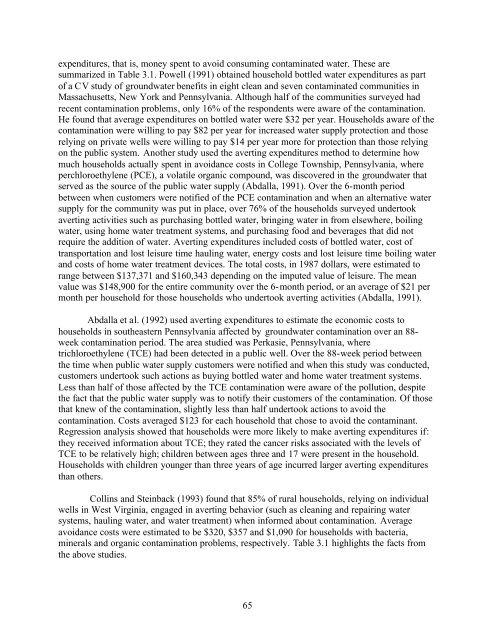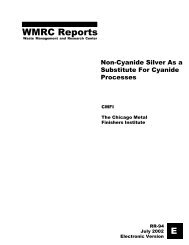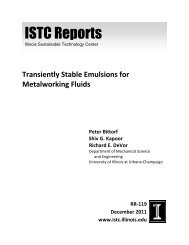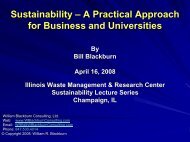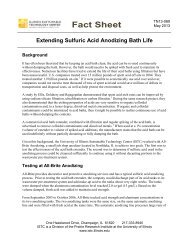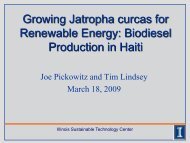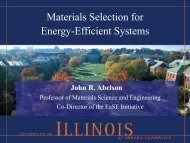Natural Resource Damage Assessment: Methods and Cases
Natural Resource Damage Assessment: Methods and Cases
Natural Resource Damage Assessment: Methods and Cases
You also want an ePaper? Increase the reach of your titles
YUMPU automatically turns print PDFs into web optimized ePapers that Google loves.
expenditures, that is, money spent to avoid consuming contaminated water. These are<br />
summarized in Table 3.1. Powell (1991) obtained household bottled water expenditures as part<br />
of a CV study of groundwater benefits in eight clean <strong>and</strong> seven contaminated communities in<br />
Massachusetts, New York <strong>and</strong> Pennsylvania. Although half of the communities surveyed had<br />
recent contamination problems, only 16% of the respondents were aware of the contamination.<br />
He found that average expenditures on bottled water were $32 per year. Households aware of the<br />
contamination were willing to pay $82 per year for increased water supply protection <strong>and</strong> those<br />
relying on private wells were willing to pay $14 per year more for protection than those relying<br />
on the public system. Another study used the averting expenditures method to determine how<br />
much households actually spent in avoidance costs in College Township, Pennsylvania, where<br />
perchloroethylene (PCE), a volatile organic compound, was discovered in the groundwater that<br />
served as the source of the public water supply (Abdalla, 1991). Over the 6-month period<br />
between when customers were notified of the PCE contamination <strong>and</strong> when an alternative water<br />
supply for the community was put in place, over 76% of the households surveyed undertook<br />
averting activities such as purchasing bottled water, bringing water in from elsewhere, boiling<br />
water, using home water treatment systems, <strong>and</strong> purchasing food <strong>and</strong> beverages that did not<br />
require the addition of water. Averting expenditures included costs of bottled water, cost of<br />
transportation <strong>and</strong> lost leisure time hauling water, energy costs <strong>and</strong> lost leisure time boiling water<br />
<strong>and</strong> costs of home water treatment devices. The total costs, in 1987 dollars, were estimated to<br />
range between $137,371 <strong>and</strong> $160,343 depending on the imputed value of leisure. The mean<br />
value was $148,900 for the entire community over the 6-month period, or an average of $21 per<br />
month per household for those households who undertook averting activities (Abdalla, 1991).<br />
Abdalla et al. (1992) used averting expenditures to estimate the economic costs to<br />
households in southeastern Pennsylvania affected by groundwater contamination over an 88week<br />
contamination period. The area studied was Perkasie, Pennsylvania, where<br />
trichloroethylene (TCE) had been detected in a public well. Over the 88-week period between<br />
the time when public water supply customers were notified <strong>and</strong> when this study was conducted,<br />
customers undertook such actions as buying bottled water <strong>and</strong> home water treatment systems.<br />
Less than half of those affected by the TCE contamination were aware of the pollution, despite<br />
the fact that the public water supply was to notify their customers of the contamination. Of those<br />
that knew of the contamination, slightly less than half undertook actions to avoid the<br />
contamination. Costs averaged $123 for each household that chose to avoid the contaminant.<br />
Regression analysis showed that households were more likely to make averting expenditures if:<br />
they received information about TCE; they rated the cancer risks associated with the levels of<br />
TCE to be relatively high; children between ages three <strong>and</strong> 17 were present in the household.<br />
Households with children younger than three years of age incurred larger averting expenditures<br />
than others.<br />
Collins <strong>and</strong> Steinback (1993) found that 85% of rural households, relying on individual<br />
wells in West Virginia, engaged in averting behavior (such as cleaning <strong>and</strong> repairing water<br />
systems, hauling water, <strong>and</strong> water treatment) when informed about contamination. Average<br />
avoidance costs were estimated to be $320, $357 <strong>and</strong> $1,090 for households with bacteria,<br />
minerals <strong>and</strong> organic contamination problems, respectively. Table 3.1 highlights the facts from<br />
the above studies.<br />
65


